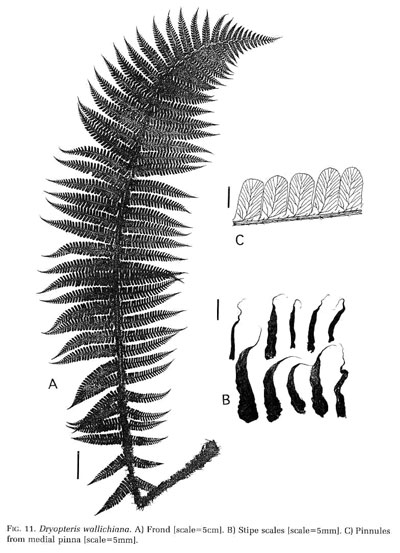| Dryopteris wallichiana | ||
|
Etymology
Named after Nathaniel Wallich (1786-1854), British pteridologist
Description
Rhizome: erect, massive, bearing several fronds in a whorl, sometimes producing offshoots, scaly.
Frond: 120 cm high by 20 cm wide, evergreen, monomorphic, blade/stipe ratio: 3:1 to 4:1. Stipe: straw-colored or darker, grooved, scales on stipes lanceolate to ovate-lanceolate, to 2.5 cm long, acuminate at apex, black or very dark brown in Asian plants, mid-brown in Central America, vascular bundles: 3-7 in a c-shaped pattern. Blade: 1-pinnate-pinnatifid, oblong-lanceolate, widest near the middle, stiff-papery, green to deep green, paler beneath, similar scales to stipe on rachis. Pinnae: 20 to 35 pair, sessile; pinnules narrowly oblong, 5--8 mm broad, roundly truncate to round at apex; costae grooved above, continuous from rachis to costae; margins irregularly dentate; veins free, forked. Sori: round, one medial row at each side of midribs of lobes, indusium: reniform, at a sinus, sporangia: brownish. Culture
Habitat: humus-rich mountain slopes in shade at 1700-3000 m.
Distribution: from Mexico to Argentina, Zimbabwe, Madagascar, Turkey, east across all of Asia below southern China, Phillippines, Hawaii, i.e., anywhere in the subtropics or tropics with a mountain above 1700 m.
Hardy to -25�C, USDA Zone 5.
Distinctive Characteristics
distinguished by narrow, dark (see above) scales, rectangular, regularly-spaced, lustrous pinnules, and conspicuous veins on the underside
Synonyms
Aspidium wallichianum Spreng Dryopteris doiana Tagawa Dryopteris paleacea (Sw.) C. Chr. Aspidium parallelogrammum Kunze Dryopteris filix-mas ssp. parallelogramma (Kunze) H. Christ Lastrea filix-mas var. paleacea Moore Nephrodium paleaceum Lowe |
|
|
|
Dryopteris wallichiana. In this Hawaian setting one is reminded of Matteuccia. �Photo by Forest & Kim Starr (USGS) |
